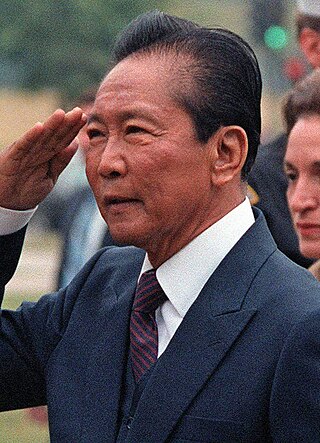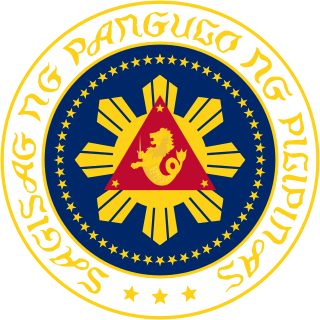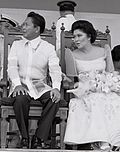
Ferdinand Emmanuel Edralin Marcos Sr. was a Filipino politician, lawyer, dictator, and kleptocrat who served as the tenth president of the Philippines from 1965 to 1986. He ruled under martial law from 1972 until 1981 and kept most of his martial law powers until he was deposed in 1986, branding his rule as "constitutional authoritarianism" under his Kilusang Bagong Lipunan. One of the most controversial leaders of the 20th century, Marcos's rule was infamous for its corruption, extravagance, and brutality.

Aquilino Quilinging Pimentel Jr., commonly known as Nene Pimentel, was a Filipino politician and human rights lawyer who was one of the leading political opposition leaders during the regime of Ferdinand Marcos from the declaration of martial law in 1972 until the People Power Revolution in 1986, which removed Marcos from power. He co-founded the Partido Demokratiko Pilipino–Lakas ng Bayan (PDP–Laban) and served as the President of the Senate of the Philippines from 2000 to 2001. He is the father of incumbent senator and former Senate President Aquilino Pimentel III. In 2018, Pimentel was identified by the Human Rights Victims' Claims Board as a Motu Proprio human rights violations victim of the Martial Law Era.
The First Quarter Storm, often shortened into the acronym FQS, was a period of civil unrest in the Philippines which took place during the "first quarter of the year 1970". It included a series of demonstrations, protests, and marches against the administration of President Ferdinand Marcos, mostly organized by students and supported by workers, peasants, and members of the urban poor, from January 26 to March 17, 1970. Protesters at these events raised issues related to social problems, authoritarianism, alleged election fraud, and corruption at the hand of Marcos.

A parliamentary election was held in the Philippines on April 7, 1978, for the election of the 165 regional representatives to the Interim Batasang Pambansa. The elections were participated in by the leading opposition party, the Lakas ng Bayan (LABAN), which had twenty-one candidates for the Metro Manila area while the leading candidate was the jailed opposition leader Ninoy Aquino, and the Marcos regime's party known as the Kilusang Bagong Lipunan (KBL), which was led by the then-First Lady Imelda Marcos. Ninoy was allowed to run by his fellow partymates under the Liberal Party, who boycotted the election and was not allowed to campaign, and so his family campaigned for him. The night before the election on April 6, 1978, a noise barrage was organized by the supporters of (LABAN) which occurred up to dawn.

Proclamation No. 1081 was the document which contained formal proclamation of martial law in the Philippines by President Ferdinand Marcos, as announced to the public on September 23, 1972.

The history of the Philippines, from 1965 to 1986, covers the presidency of Ferdinand Marcos. The Marcos era includes the final years of the Third Republic (1965–1972), the Philippines under martial law (1972–1981), and the majority of the Fourth Republic (1981–1986). By the end of the Marcos dictatorial era, the country was experiencing a debt crisis, extreme poverty, and severe underemployment.
A constitutional convention was called to change the 1935 Constitution of the Philippines, written to establish the Commonwealth of the Philippines. A special election was held on November 10, 1970 to elect the convention's delegates, which would convene in 1971.
The Philippine constitutional plebiscite of 1973 occurred from 10 to 15 January which ratified the 1973 Constitution of the Philippines.

The Plaza Miranda bombing occurred during a political rally of the Liberal Party at Plaza Miranda, Quiapo district, Manila, the Philippines on August 21, 1971. It caused nine deaths and injured 95 others, including many prominent Liberal Party politicians.

Martial law in the Philippines refers to the various historical instances in which the Philippine head of state placed all or part of the country under military control—most prominently during the administration of Ferdinand Marcos, but also during the Philippines' colonial period, during the second world war, and more recently on the island of Mindanao during the administrations of Gloria Macapagal Arroyo and Rodrigo Duterte. The alternative term "martial law era" as applied to the Philippines is typically used to describe the Marcos martial law period specifically.

The 1969 Philippine presidential and vice presidential elections were held on November 11, 1969. Incumbent President Ferdinand Marcos won a second full term as President of the Philippines. Marcos was the last president in the entire electoral history of the Philippines who ran for and won a second term. His running mate, incumbent Vice President Fernando Lopez, was also elected to a third full term as Vice President of the Philippines. A total of twelve candidates ran for president, but ten of those got less than 0.01% of the vote.
Edgardo Gil Mirasol Jopson, more popularly known as Edgar Jopson or Edjop, was a Filipino activist and active member of the Communist Party of the Philippines (CPP) during the reign of former President Ferdinand Marcos Sr. Jopson studied in Ateneo de Manila High School, and later proceeded to Ateneo de Manila University where he graduated under the Management Engineering program, garnering Latin Honors. He was active in politics since his years in college, even becoming the president of the National Union of Students of the Philippines (NUSP). He later went underground with the CPP when President Marcos declared Martial Law in 1972. He was killed during a military raid in his house in 1982.
Student activism in the Philippines from 1965 to 1972 played a key role in the events which led to Ferdinand Marcos' declaration of Martial Law in 1972, and the Marcos regime's eventual downfall during the events of the People Power Revolution of 1986.

At 7:15 p.m. on September 23, 1972, President Ferdinand Marcos announced on television that he had placed the Philippines under martial law, stating he had done so in response to the "communist threat" posed by the newly founded Communist Party of the Philippines (CPP), and the sectarian "rebellion" of the Muslim Independence Movement (MIM). Opposition figures of the time accused Marcos of exaggerating these threats and using them as an excuse to consolidate power and extend his tenure beyond the two presidential terms allowed by the 1935 constitution. Marcos' signed Proclamation No. 1081 on September 21, 1972, marking the beginning of a fourteen-year period of one-man rule which effectively lasted until Marcos was exiled from the country on February 25, 1986. Proclamation No. 1081 was formally lifted on January 17, 1981, although Marcos retained essentially all of his powers as dictator until he was ousted in February 1986.

The Movement of Concerned Citizens for Civil Liberties (MCCCL) is an advocacy coalition in the Philippines which was first formed under the leadership of José W. Diokno in 1971, as a response to the suspension of the Writ of Habeas Corpus in the wake of the Plaza Miranda bombing. It became well known for the series of rallies which it organized from 1971–72, especially the most massive one on September 21, 1972, hours before the imposition of martial law by the Marcos dictatorship.

The Philippine Constitutional Convention of 1971 was called to change the 1935 Constitution of the Philippines. The delegates were elected on November 10, 1970, and the convention itself was convened on June 1, 1971. It was marked by controversies, including efforts to uphold term limits for incumbent President Ferdinand Marcos, and a bribery scandal in which 14 people, including First Lady Imelda Marcos, were accused of bribing delegates to favor the Marcoses.

The 21-year period of Philippine economic history during Ferdinand Marcos’ regime – from his election in 1965 until he was ousted by the People Power Revolution in 1986 – was a period of significant economic lows.
The protest during Ferdinand Marcos' Fifth State of the Nation Address on January 26, 1970, and its violent dispersal by police units, marked a key turning point in the administration of Ferdinand Marcos, and the beginning of what would later be called the "First Quarter Storm" a period of civil unrest in the Philippines which took place during the first quarter of the year 1970.
The National Union of Students of the Philippines is an alliance of student councils in the Philippines established in 1957. Advocating for democratic rights of students, it boasts about 600 member councils and is part of International Union of Students (IUS) and the Asia Pacific Youth and Students Association (ASA). It is also a member and a founding organization of Kabataan Partylist.
The alleged September 22, 1972, ambush attack on the then-Defense Minister of the Philippines Juan Ponce Enrile is a disputed incident in which Enrile's white Mercedes-Benz sedan was ambushed near the upscale Wack Wack village in Mandaluyong, Metro Manila. It was cited by President Ferdinand Marcos as the proximate incident which led to the announcement of Marcos' declaration of martial law the following day, although Marcos would later claim that he signed the formal proclamation of martial law on September 21, the day before the Enrile ambush.














